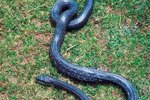
Of the 160 types of snake that inhabit North America, only 20 are venomous. Although snake bites may be painful for their victims to endure, snakes occupy an important niche in the food chain, and their valuable venom is sometimes used in the medical field, specifically in some cancer treatments. Venomous snakes in North America can be classified as either pit vipers or coral snakes.
North American Rattlesnakes
As members of the pit viper family, rattlesnakes possess a telltale heat-sensitive pit located between the eye and nostril on either side of their face. North America is home to 16 types of rattlesnake, including the diminutive pygmy rattlesnake that may reach lengths of 1.5 feet, or the much larger eastern diamondback rattlesnake that can grow to 6 feet on average. Rattlesnakes prefer to dine upon creatures that humans consider to be pests, such as mice, rats and rabbits, according to the Florida Museum of Natural History.
Copperhead Snakes
Greyish-brown to pinkish-tan in color and adorned with an hourglass pattern, shy copperhead snakes lure with their yellow tails frogs and toads to their waiting jaws. The copperhead prefers to make its habitat along the edges of forests and on rocky ledges, though it can be found near stream banks. Copperhead snakes utilize their camouflage to avoid predators in dead leaves, staying completely still when they sense danger. Though the snakes prefer to avoid human contact at all costs, they will not hesitate to strike a perceived intruder without warning, according to the North Carolina State University Cooperative Extension. The venom of a copperhead snake is less potent than that of other pit vipers.
Cottonmouth or Water Moccasin
The water-loving cottonmouth, or water moccasin, appears dark brown or black with very little patterning on the scales, according to the Missouri Department of Conservation, though the young of the species may resemble the copperhead due to their lighter color and yellow tail. Reaching 42 inches in length, the cottonmouth feeds primarily on fish, but may also consume rodents, frogs, lizards and other snakes. While highly venomous, the snakes usually warn intruders of a potential strike by opening their jaws to expose the white lining of their mouths.
Coral Snakes
Equipped with vivid red and black bands bordered by yellow rings, the coral snake is rarely seen by humans, but thought to be the most venomous snake in the United States. Coral snakes enjoy the cover that a pile of leaves may provide, but usually prefer to be out of sight in burrows underground. Coral snakes belong in the Elapidae family, which is the same biological family as cobras, according to the Acton Nature Center. There are two types in the United States: The eastern coral snake, which inhabits the region between Texas and North Carolina, and the Arizona coral snake which prefers the arid climates of southern Arizona and southwestern New Mexico.
References
- Center for Disease Control and Prevention: Venomous Snakes
- USA Tourist: Poisonous Snakes
- Back Yard Nature: Venomous Snakes in North America
- Acton Nature Center: Venomous Snakes
- Mike Outdoors: Venomous Snakes of North America
- Missouri Department of Conservation: Western Cottonmouth
- University of Florida: Eastern Diamondback Rattlesnake
- North Carolina State University Cooperative Extension: How Dangerous are Copperhead Snakes?
- Missouri Department of Conservation: Osage Copperhead
Photo Credits
-
Jupiterimages/Photos.com/Getty Images




